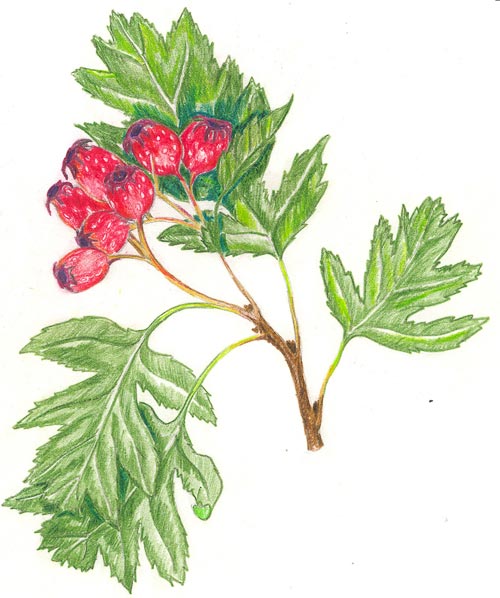Relatives
Crataegus pinnatifida Bunge - Chinese hawthorn.
Taxonomic position.
Family Rosaceae Juss. genus Crataegus L.Synonyms.
Mespilus pinnatifida C. Koch., Crataegus oxyacantha var. pinnatifida Regel.Morphology and biology.
Large shrub or small tree, up to 6 m tall. Branches are dark gray, with few straight, brown thorns 1-2 cm in length or, sometimes, without thorns. Leaves range from pinnately parted to almost dissected, with 2-4 pairs of oblong-triangular, sharp lobes. Leaf blades are 5-8 cm long and 4-6 cm wide, ovate or oblong-ovate, with a wedge-shaped base, serrated; young ones are bare, glossy, bright green from above, while underneath they vary from bare to pubescent along the veins to having patches of hair in the corners of the veins. Stipules are curved in a crescent-like fashion, 1.5 cm in length. Flowers are grouped into polyanthous (15-20) drooping inflorescences. Pedicels are naked or thinly pilose. Corollas are white, frequently turning pink at the end of flowering, 8-12 mm in diameter. Stamens have pink anthers. Fruit are 12-18 mm in diameter, varying from obovate and pear-shaped to spherical, glossy scarlet with white blotches; flesh is firm, pink. Seeds are yellowish brown, 3-5 in number. Entomophilous. Ornitochore. Propagated by seed and summer cuttings. Seeds need to be stratified for 7 months at 3-5°C. Blossoms in May and the first half of June; bears fruit in August-September. Chromosome number: 2n = 34.Distribution.
Far East (in the vicinity of the Amur River and in the Maritime Territory), Northeastern China and Korea.Ecology.
Mesophyte. Photophilous, relatively shade-tolerant. Grows as single plants and in small groups in valleys of rivers and brooks, in the lower part of near-valley hill slopes, in willow groves, in elm and ash forests, and on sandy shores.Utilization and economic value.
Food (fruit), nectariferous, medicinal and ornamental plant. Its cultivation reportedly started more than 100 years ago. It is one of the most ornamental hawthorns. Fruit have pleasing though sour taste. They are eaten fresh or used in jams and jellies. In northern China, it is a more significant fruit-bearing plant than the apple tree.References:
Kharkevich S.S., ed. 1996. Vascular plants of the Soviet Far East. V. 8. Leningrad: Nauka, pp. 148. (in Russian).Koropachinskiy, I.Yu., Vstovskaya, T.N. 2002. Woody plants of the Asian part of Russia. Novosibirsk: Publishing House of SB RAS, Branch "Geo", pp. 319-321. (in Russian).
Sokolov, S.I., Svjaseva, O.A., Kubli, V.A. 1980. Areas of distribution of trees and shrubs in the USSR. V. 2. Leningrad: Nauka, pp. 73. (in Russian).
Vulf, E.V., Maleyeva, O.F. 1969. Worldwide resources of useful plants. Reference book. Leningrad: Nauka, 563 p. (in Russian).


